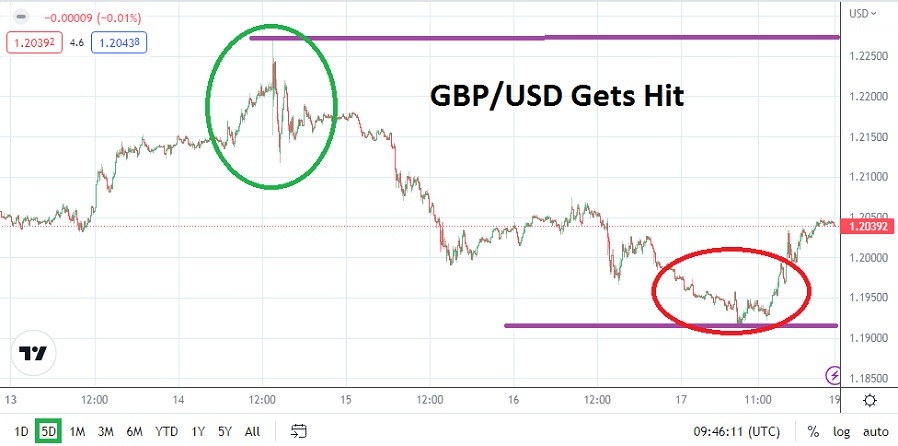On Tuesday this past week, the GBP/USD was happily moving higher as strong buying was being demonstrated, as financial houses and traders embraced the notion a weaker-than-expected U.S Consumer Price Index report would soon be published. On the 14th of February, yes, Valentine’s Day, the GBP/USD was touching the 1.22700 ratios with fast bullish activity, when suddenly trading outlooks went from cheerful optimism and returned to potentially dark shadows.
Following in the wake of the U.S CPI data which showed American inflation remained stubborn and confirmed the U.S Federal Reserve’s rather aggressive monetary policy rhetoric a couple of weeks before, the GBP/USD started to sell off. By Wednesday morning the GBP/USD was trading below the 1.19900 level, this before it started to reverse higher and attained a high on Thursday around the 1.20775 mark. Apparently, some skeptics about U.S. inflation remained and the GBP/USD was able to find some buying support.
Technical traders were likely starting to dream of a higher GBP/USD again if they held bullish outlooks and believed another dose of inflation data from the U.S. on Thursday would deliver better inflation news. However, following the brief high displayed by the GBP/USD early on Thursday, the U.S. released its Producer Price Index figures and this time there was no mistaking the road signs warning about strong U.S. inflation. Not only did the PPI numbers come in with a stubborn result, but they also came in actively higher than anticipated.
Top Forex Brokers
GBP/USD hit depths not seen since the first week in January on Friday
On early Friday the GBP/USD fell below the 1.19200 ratio and bullish speculators of the Forex pair who were holding out were likely forced out of long positions. Yes, the GBP recovered as Friday moved on, and it finished the week near the 1.20390 vicinities where it will start trading on Monday morning. The notion the U.S. Federal Reserve will raise interest rates in March and potentially soon after that is almost a certainty.
- Having broken important support near the 1.20000 ratios on Wednesday, Thursday, and Friday of last week with incrementally lower depths in succession is not a bullish sign for the GBP/USD.
- Financial houses and traders who believed inflation would show it is declining in the U.S. were dealt strong punches, and the U.S. central bank is now in a position where it can be expected to likely raise interest rates over the mid-term.
Interest Rate over 5.00% likely from the U.S Federal Reserve in the Mid-Term
GBP/USD traders now have to find their equilibrium once again. Having sustained a solid bullish trend since the dog days of political upheaval in the U.K. this summer and early this fall, the GBP/USD climbed significantly and achieved a rather steady buying cycle. However, moving forward in the near-term nervous sentiment regarding the U.S. Fed outlook will affect the GBP/USD and support levels will be watched carefully. Traders may want to keep in mind there is a banking holiday in the U.S. on Monday, which will affect volumes and may make the GBP/USD slightly more volatile if uneven transactions are encountered.
GBP/USD Weekly Outlook:
The speculative price range for GBP/USD is 1.18450 to 1.22210
The 1.20000 is now an important psychological mark for the GBP/USD. Bearish and bullish traders will be keen to see if this level can be sustained early this week. If the 1.20000 is proven vulnerable, traders may believe there will be additional selling action, which could come within sight of lower values displayed last week. Traders should not be overly ambitious and be willing to cash out winning wagers when they are accomplished.
Looking for the GBP/USD to suddenly break below the 1.19000 mark may seem too far. This Tuesday the U.K. will publish PMI readings and on Thursday the U.S. will release Preliminary GDP data. Both of these reports will affect the GBP/USD and cause volatility. The Bank of England will no doubt be a position to follow the U.S. Federal Reserve’s monetary policy lead and raise interest rates too over the mid-term. This could provide some behavioral sentiment strength for the GBP/USD regarding buying, but it is not guaranteed.
If the GBP/USD can sustain value above the 1.20000 ratios over the near term and go into Tuesday’s U.K. Purchasing Managers Index reports with calm price action, the GBP/USD could find some bullish momentum with a report that meets expectations. However, speculators should expect this week to provide more fireworks, particularly if the U.S. Gross Domestic Product numbers come in with a better outcome than expected. If the U.S. growth numbers are stronger, this could send the GBP/USD lower again.
Ready to trade our weekly Forex analysis? We’ve made a list of the best brokers to trade Forex worth using.

